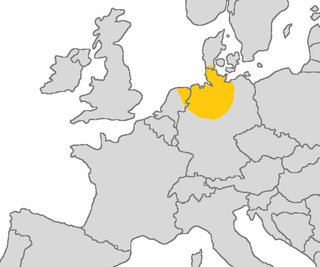The accusative case of a noun is the grammatical case used to mark the direct object of a transitive verb. The same case is used in many languages for the objects of prepositions. It is a noun that is having something done to it, usually joined with the nominative case.

Danish is a North Germanic language spoken by around six million people, principally in Denmark and in the region of Southern Schleswig in northern Germany, where it has minority language status. Also, minor Danish-speaking communities are found in Norway, Sweden, Spain, the United States, Canada, Brazil, and Argentina. Due to immigration and language shift in urban areas, around 15–20% of the population of Greenland speak Danish as their first language.
Passive voice is a grammatical voice common in many languages. In a clause with passive voice, the grammatical subject expresses the theme or patient of the main verb – that is, the person or thing that undergoes the action or has its state changed. This contrasts with active voice, in which the subject has the agent role. For example, in the passive sentence "The tree was pulled down", the subject denotes the patient rather than the agent of the action. In contrast, the sentences "Someone pulled down the tree" and "The tree is down" are active sentences.
In linguistics, syntax is the set of rules, principles, and processes that govern the structure of sentences in a given language, usually including word order. The term syntax is also used to refer to the study of such principles and processes. The goal of many syntacticians is to discover the syntactic rules common to all languages.
Traditional grammar defines the object in a sentence as the entity that is acted upon by the subject. There is thus a primary distinction between subjects and objects that is understood in terms of the action expressed by the verb, e.g. Tom studies grammar—Tom is the subject and grammar is the object. Traditional theories of sentence structure divide the simple sentence into a subject and a predicate, whereby the object is taken to be part of the predicate. Many modern theories of grammar, in contrast, take the object to be a verb argument like the subject, the difference between them being mainly just their prominence; the subject is ranked higher than the object and is thus more prominent.
In linguistics, an adjunct is an optional, or structurally dispensable, part of a sentence, clause, or phrase that, if removed or discarded, will not otherwise affect the remainder of the sentence. Example: In the sentence John helped Bill in Central Park, the phrase in Central Park is an adjunct.
The subject in a simple English sentence such as John runs, John is a teacher, or John was ran over by a car is the person or thing about whom the statement is made, in this case 'John'. Traditionally the subject is the word or phrase which controls the verb in the clause, that is to say with which the verb agrees. If there is no verb, as in John - what an idiot!, or if the verb has a different subject, as in John - I can't stand him!, then 'John' is not considered to be the grammatical subject, but can be described as the 'topic' of the sentence.
In linguistics, the topic, or theme, of a sentence is what is being talked about, and the comment is what is being said about the topic. This division into old vs. new content is called information structure. It is generally agree that clauses are divided into topic vs. comment, but in certain cases the boundary between them depends on which specific grammatical theory is being used to analyze the sentence.
A finite verb is a form of a verb that has a subject and can function as the root of an independent clause; an independent clause can, in turn, stand alone as a complete sentence. In many languages, finite verbs are the locus of grammatical information of gender, person, number, tense, aspect, mood, and voice. Finite verbs are distinguished from non-finite verbs, such as infinitives, participles, gerunds etc., which generally mark these grammatical categories to a lesser degree or not at all, and which appear below the finite verb in the hierarchy of syntactic structure. Verbs were originally said to be finite if their form limited the possible person and number of the subject. In some languages, such as English, this does not apply.

Spanish grammar is the grammar of the Spanish language, which is a Romance language that originated in north central Spain and is spoken today throughout Spain, some twenty countries in the Americas, and Equatorial Guinea in Africa.

Old Saxon, also known as Old Low German, was a Germanic language and the earliest recorded form of Low German. It is a West Germanic language, closely related to the Anglo-Frisian languages. It has been documented from the 8th century until the 12th century, when it gradually evolved into Middle Low German. It was spoken throughout modern northwestern Germany, primarily in the coastal regions and in the eastern Netherlands by Saxons, a Germanic tribe who inhabited the region of Saxony. It partially shares Anglo-Frisian's Ingvaeonic nasal spirant law which sets it apart from Low Franconian and Irminonic languages, such as Dutch, Luxembourgish and German.
In linguistics, a stative verb is one that describes a state of being, in contrast to a dynamic verb, which describes an action. The difference can be categorized by saying that stative verbs describe situations that are static or unchanging throughout their entire duration, whereas dynamic verbs describe processes that entail change over time. Many languages distinguish between these two types in terms of how they can be used grammatically.

Tzotzil is a Maya language spoken by the indigenous Tzotzil Maya people in the Mexican state of Chiapas. Most speakers are bilingual in Spanish as a second language. In Central Chiapas, some primary schools and a secondary school are taught in Tzotzil. Tzeltal is the most closely related language to Tzotzil and together they form a Tzeltalan sub-branch of the Mayan language family. Tzeltal, Tzotzil and Chʼol are the most widely spoken languages in Chiapas.
In pedagogy and theoretical syntax, a sentence diagram or parse tree is a pictorial representation of the grammatical structure of a sentence. The term "sentence diagram" is used more in pedagogy, where sentences are diagrammed. The term "parse tree" is used in linguistics, where sentences are parsed. Both shows structure of sentences. The model is informative about the relations between words and the nature of sentence structure and is therefore used as a tool to help predict which sentences are and are not possible.
German declension is the paradigm that German uses to define all the ways articles, adjectives and sometimes nouns can change their form to reflect their role in the sentence: subject, object, etc. Declension allows speakers to mark a difference between subjects, direct objects, indirect objects and possessives by changing the form of the word—and/or its associated article—instead of indicating this meaning through word order or prepositions. As a result, German can take a much more fluid approach to word order without the meaning being obscured. In English, a simple sentence must be written in strict word order. This sentence cannot be expressed in any other word order than how it is written here without changing the meaning. A translation of the same sentence from German to English would appear rather different and can be expressed with a variety of word order with little or no change in meaning.
In linguistics, an argument is an expression that helps complete the meaning of a predicate, the latter referring in this context to a main verb and its auxiliaries. In this regard, the complement is a closely related concept. Most predicates take one, two, or three arguments. A predicate and its arguments form a predicate-argument structure. The discussion of predicates and arguments is associated most with (content) verbs and noun phrases (NPs), although other syntactic categories can also be construed as predicates and as arguments. Arguments must be distinguished from adjuncts. While a predicate needs its arguments to complete its meaning, the adjuncts that appear with a predicate are optional; they are not necessary to complete the meaning of the predicate. Most theories of syntax and semantics acknowledge arguments and adjuncts, although the terminology varies, and the distinction is generally believed to exist in all languages. Dependency grammars sometimes call arguments actants, following Tesnière (1959).
Arosi is a Southeast Solomonic language spoken on the island of Makira. Arosi is primarily spoken by inhabitants who live to the west of the Wango River on San Cristoval Island (Makira). San Cristoval is in the eastern most part of the Solomon Islands. San Cristoval was discovered and named by Álvaro de Mendaña de Neira in 1588. Upon landing on San Cristoval, the Spanish were the first began to record Arosi, but only six words were initially recorded. Arosi is one of the lesser known languages in Melanesia.
The Copenhagen School, officially the Linguistic Circle of Copenhagen, is a group of scholars dedicated to the study of linguistics. It was founded by Louis Hjelmslev (1899–1965) and Viggo Brøndal (1887–1942). In the mid twentieth century the Copenhagen school was one of the most important centres of linguistic structuralism together with the Geneva School and the Prague School. In the late 20th and early 21st century the Copenhagen school has turned from a purely structural approach to linguistics to a functionalist one, Danish functional grammar, which nonetheless incorporates many insights from the founders.
In grammar, the voice of a verb describes the relationship between the action that the verb expresses and the participants identified by its arguments. When the subject is the agent or doer of the action, the verb is in the active voice. When the subject is the patient, target or undergoer of the action, the verb is said to be in the passive voice. Voice is sometimes called diathesis.







